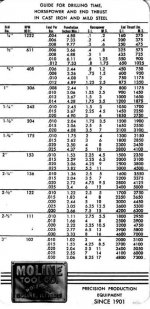JasonPAtkins
Hot Rolled
- Joined
- Sep 30, 2010
- Location
- Guinea-Bissau, West Africa
Hey all, I have a pretty good set of MT drills for my MT4 15x48 5hp Colchester. I'm considering jumping into the world of spade drills, because I do a lot of hogging solid stock since I can't order heavy wall tube when I need it.
Is there a general rule of thumb for HP needed to drive a spade drill? For example, the auction lot I'm watching has a bunch of big stuff, but I assume that my 5hp will never be enough to drive anything bigger than a 2" spade. Is that number actually smaller, like 1-1/2"?
Is there a general rule of thumb for HP needed to drive a spade drill? For example, the auction lot I'm watching has a bunch of big stuff, but I assume that my 5hp will never be enough to drive anything bigger than a 2" spade. Is that number actually smaller, like 1-1/2"?



